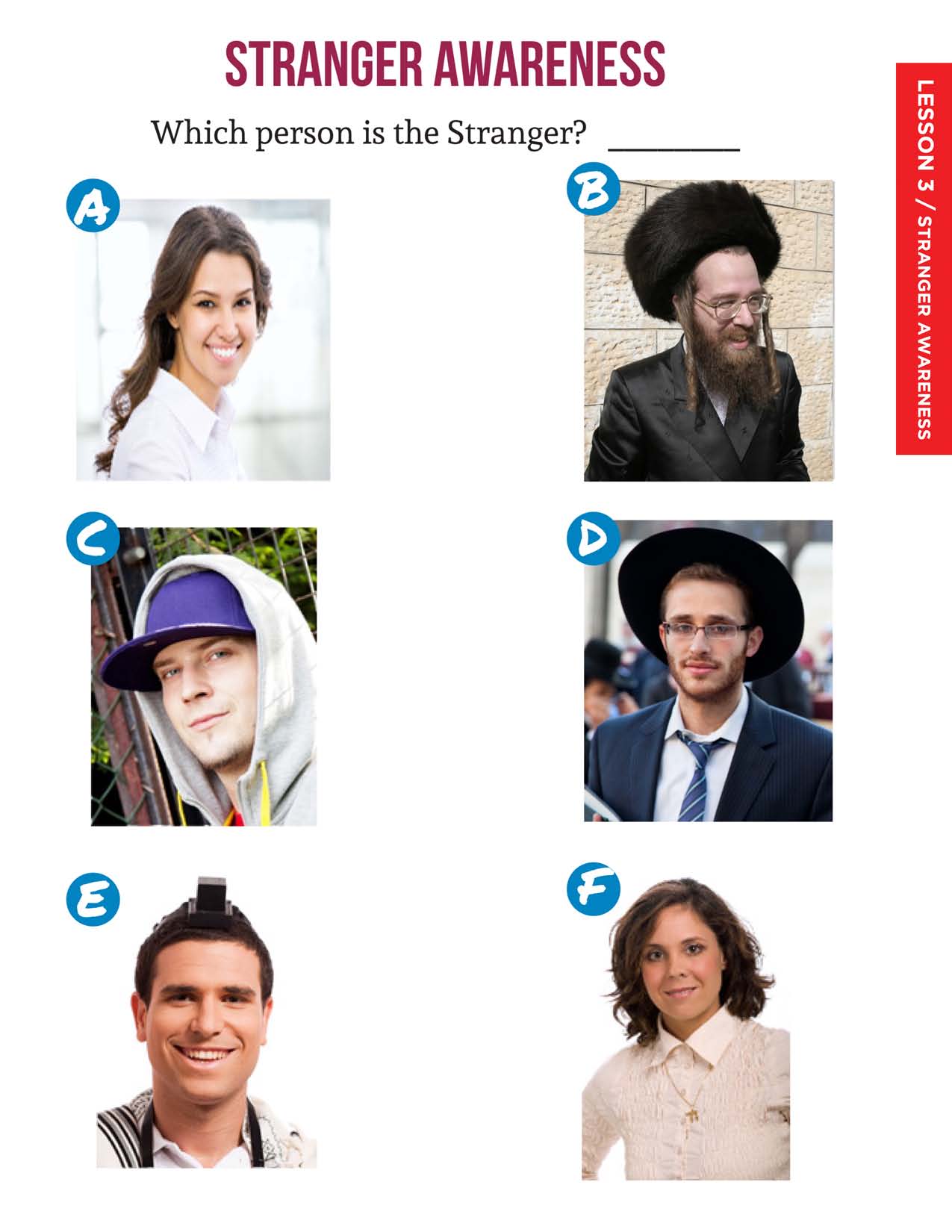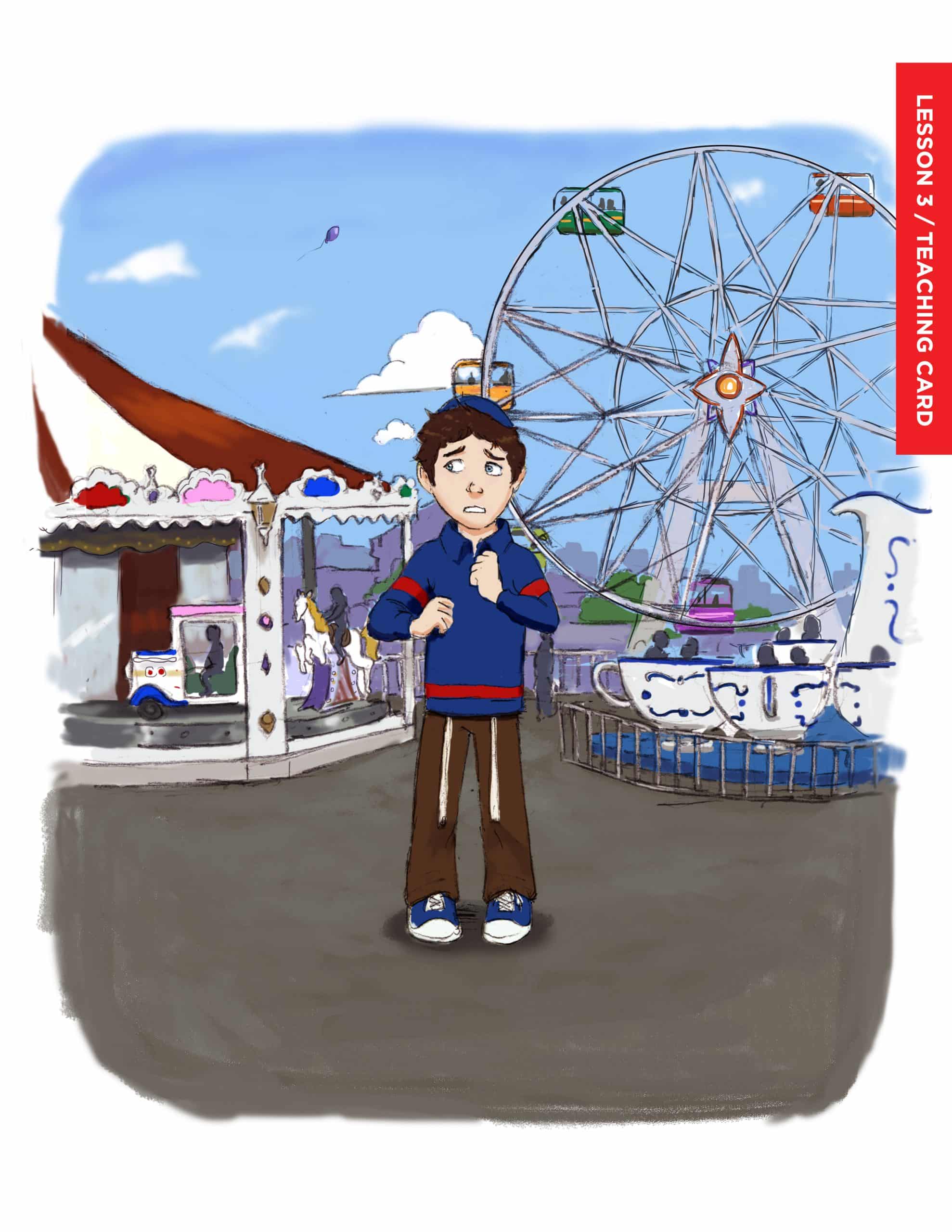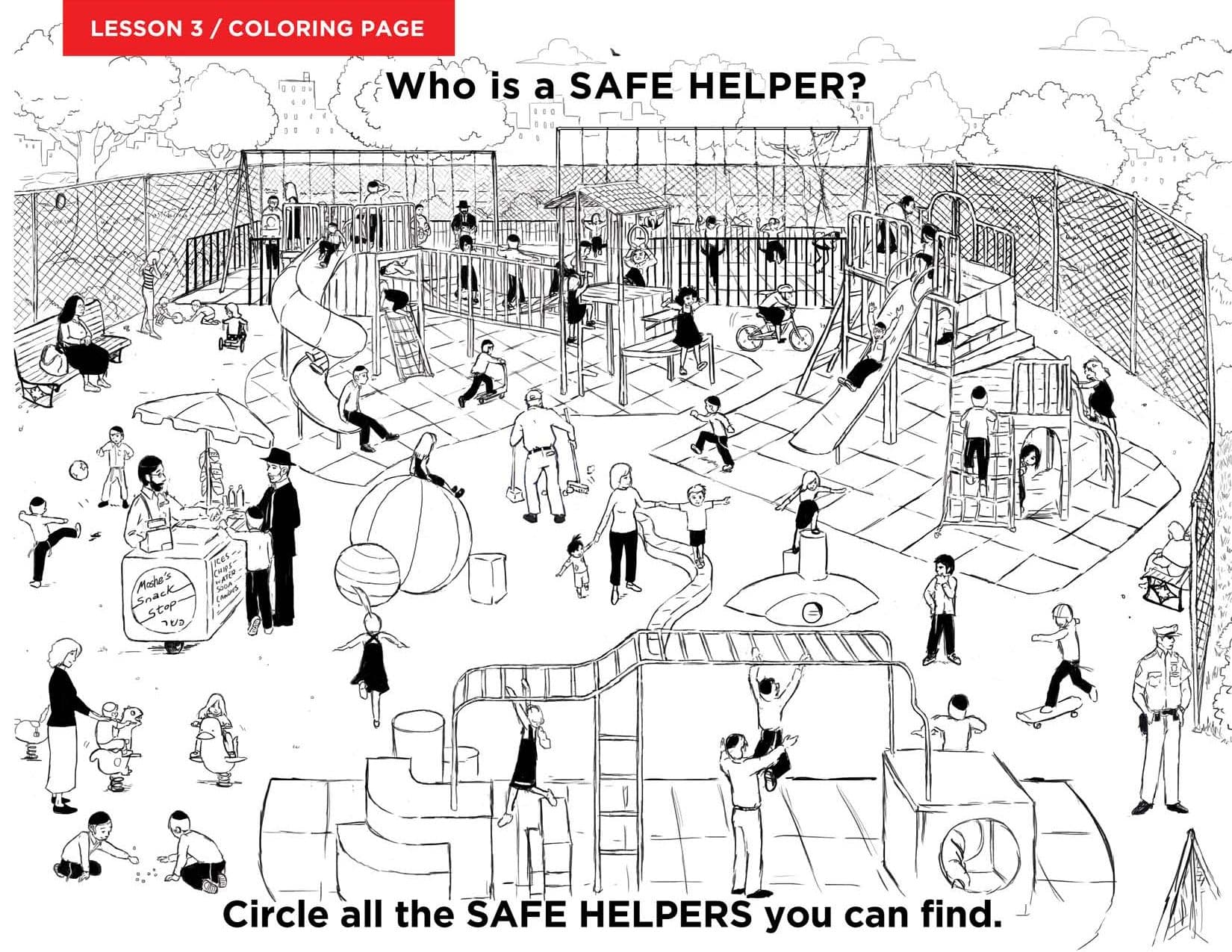
Who is a stranger?
Give each child a piece of blank paper and something to write or draw with. Give the students instructions to
draw their idea of a stranger. Tell them there is no right or wrong answer and they should just be creative and draw whatever comes to mind when they think of the word stranger. Give them some time to draw.
Most kids will draw sinister-looking people because that’s the connotation that comes to mind when they
think of a stranger.
Discuss the student’s pictures commentating on the creepiness or scariness factors they have drawn.
(Hold up stranger card)
Okay, now what about the people in this card? Which of these people do you think is a stranger?

(Most kids will choose person C with the baseball cap and hoodie since he doesn’t look Jewish to them, then throw some questions out to them while pointing to some of the individuals such as “Is this person married?” “where does this person live?” Does this person have any children?” etc. The idea is that no matter what they look like we still do not know them.)
Answer: they are all strangers because you don’t know any of them. A Stranger is anybody that you don’t know. That means, not only doesn’t a stranger need to look like a creepy scary person, but he/she could actually look like anyone. All the people on this card are strangers and they are all probably really nice, but it still doesn’t take away the fact that they are strangers.
It’s common for children to think that “bad strangers” look scary. This is not only false but, dangerous for children to think this way. However, don’t make it seem like all strangers are bad. If children need help–whether they’re lost, being threatened by a bully, or being followed by a stranger–the safest thing for them to do in many cases is to ask a stranger for help.
There are certain times when we may need help from a stranger and knowing the safest way to do this is important. Let’s take an example
(Use the teaching card of the boy lost in an amusement park)
Tell a story about Daniel getting lost in an Amusement Park. Go into detail about the concept that although he and they may be older kids, you can spend your entire day running around in circles… as the people you came with go one way and you go another…discuss the concept of setting up a meeting place in case of separation.
Now let’s use our Stop, think, Act method we used last time to help with this scenario.
STOP: Take a deep breath (why?)
THINK: 1. how do you think Daniel would be feeling? Is it safe or unsafe?
2. What’s the safety rule?
ACT: 1. Going to a safe place 2. Telling a safe adult.

Staying in a public place with lots of people around is a safe place to be. We need a Safe Stranger and the #1 Safe Stranger is a mother with children.
Why? A mother knows what it’s like to lose her child and she will make sure you get help.
Am I a mother with children? (have kids discuss this concept making sure they understand the woman has to have children with her. Show the mother with the children’s card to help).
Who are other good safe strangers? The cashier at the front of the store. Why? He/She has a microphone so she can page someone if you need. A security guard who stands at the entrance to the store is another possibility.
(Show card with 3 safe helpers).
Children may feel uncomfortable talking to someone they do not know or asking for help. Some may also feel as if they can take care of themselves and are mature enough to figure things out. Discuss the following possibilities taking time to discuss their feelings in each situation and who they can approach for help. Use the Stop, think, act steps as you go.
Scenario #1: As you are looking around for a Safe Stranger, a Jewish man with a beard and a yarmulke comes over to help. The man looks familiar. He offers to help you look for your friend/parent/buddy. Think about how you would feel. Is it safe to go with the man to look?
STOP: take a deep breath
THINK: I am feeling nervous. I think I recognize the man so I don’t necessarily think of him as a stranger. He is probably really nice. The rule is I need to find a safe stranger and he isn’t on the list.
ACT: look for a safe stranger. If he is the only one you can find you can ask to borrow his cellphone and call someone or have him go to announce where you are waiting, but never leave the public place or go anywhere even with a safe stranger.
Scenario #2: After looking around you don’t see a Safe Stranger right away. The cashier in the store is busy with a line full of people waiting to pay. There was no security guard standing around or anyone else with a uniform. You see a few women and teenage girls but are not sure it’s the right strangers to ask. You think “I bet my friends didn’t see me and thought I went to look
for them by the car. I will go to the parking lot. What do you think? Is it safe to go check the car? Does this make sense?
Answer: the person who is looking for you is not going to leave without you, discuss this concept with the students and why it would be dangerous to go to a parking lot or to the street.
Scenario #3: You spot a mother with children, but see that she may not be Jewish. She does not seem to be covering her hair and she is wearing pants. What do you think? How you would feel? Is it safe?
Answer: We never said the #1 Safety Stranger can only be a Jewish mother with children. It’s any mother with children since all mothers feel the same way about losing their children, even mothers who may not be Jewish. Discuss the feelings involved.
(Use teaching cards and talk about getting lost while walking home from school – the possibility of being distracted while walking. Talk about what to do when you are near businesses, residential areas, etc. Talk about what to do if an Adult pulls over asking for directions- Remember a safe adult does not ask a child for directions).
Make sure to reiterate to ask a safe stranger for help, but to never leave anywhere with the individual. Staying in a public place is safest.
Remember, if this happens to you and you feel nervous, worried, or anxious, you can always tell your feelings to a Trusted Adult so they can help you feel comfortable and come up with a way to feel safe in the future. There is no time limit to when you can share your feelings with the Trusted Adults in your life. They are always there to help make you feel safe.
